Cities get mired in civil rights disputes in trying to deal with growing homeless populations
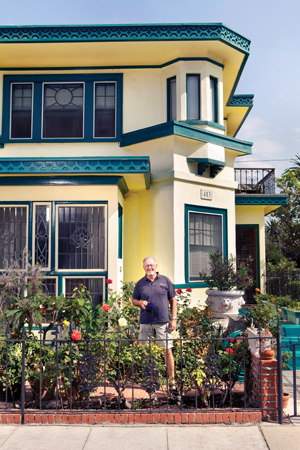
Photo of Mark Ryavec by Kyle Monk.
He's about half a mile from the shore and even closer to Abbot Kinney Boulevard, a trendy artery filled with pricey restaurants and boutiques. Depending on which real estate website you consult, his improvements and recent gentrification in the area have pushed the property's value to roughly three or four times what he paid for it in 1989.
Across the street, one of his sometime neighbors lives in a van.
Drinking coffee in his front yard, Ryavec watches a young man slip out. Shortly afterward, the man comes back with a car that jump-starts the van. This is necessary because it's a street sweeping day and the space ceases to be legal at noon. This, Ryavec says, means the van-dweller will take up a parking spot that a resident could be using—in a parking-poor neighborhood that gets 16 million visitors a year.
But this is just the beginning of Ryavec's problems with homelessness in Venice Beach. A much smellier problem is that people living in vehicles have limited access to bathrooms. As a result, he says, vehicle-dwellers routinely relieve themselves behind million-dollar homes.
"There's a street down there, and they'll have two or three [vehicle-dwellers], and it's like their alley is the one that's consistently used as a toilet," he says. Homeowners "used to call the police all the time ... and now they can't do that. Unless they snap a photo of them in the process —[and] who wants to stake that kind of thing out?"
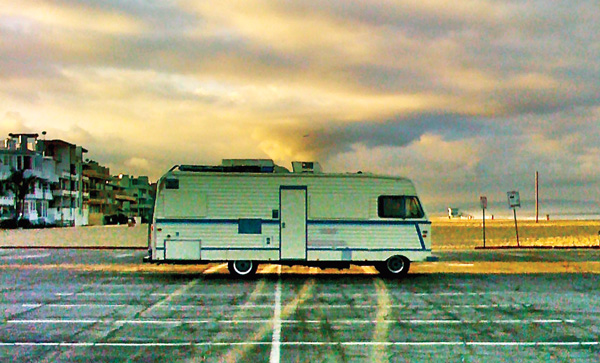
A homeless camper in a Venice Beach, California, parking lot. Photo by Jennifer Kelton.
Ryavec's neighbors can no longer call the police without proof of public elimination because of Desertrain v. City of Los Angeles. On June 19, the 9th U.S. Circuit Court of Appeals at San Francisco struck down a Los Angeles city ordinance forbidding using a vehicle "as living quarters either overnight, day by day or otherwise." The unanimous three-judge panel ruled that the ordinance was unconstitutionally vague, overturning a district court's summary judgment ruling.
"Section 85.02 is broad enough to cover any driver in Los Angeles who eats food or transports personal belongings in his or her vehicle," wrote Judge Harry Pregerson. "Yet it appears to be applied only to the homeless. The vagueness doctrine is designed specifically to prevent this type of selective enforcement."
This displeases Ryavec, president of a group called the Venice Stakeholders Association that is pushing for more city intervention in Venice's homeless problem. It's had some success; citations for vehicle-dwellers grew substantially after increased neighborhood complaints.
But the courts have complicated things. Desertrain is the third in a line of 9th Circuit cases striking down LA's homelessness laws. In 2012, the court ruled in Lavan v. City of Los Angeles that seizing and destroying the personal possessions of homeless people, left on sidewalks so their owners could go inside to do things like shower, violates the Fourth and 14th amendments. The city now must hold seized possessions for 90 days before destroying them.
And in 2006, the 9th Circuit ruled in Jones v. City of Los Angeles that it's cruel and unusual to punish people for sitting, sleeping or lying on public roads at night. The resulting settlement required the city to permit sleeping on sidewalks from 9 p.m. to 6 a.m. until an additional 1,250 units of supportive housing were built.
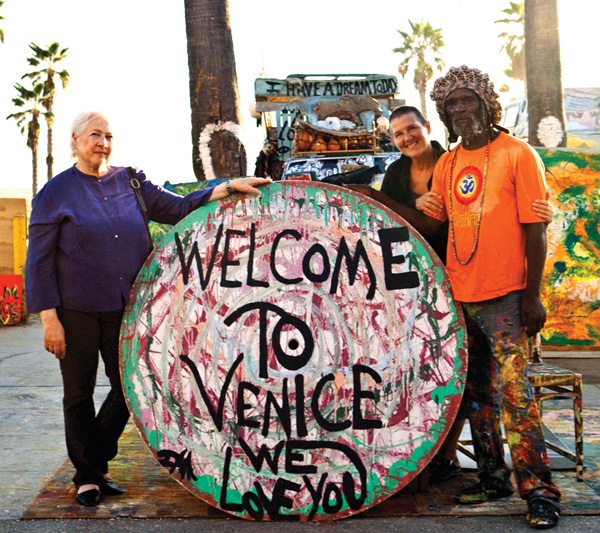
Carol Sobel questions whether community leaders have the political will to advance long-term solutions to homelessness. Photo by Kyle Monk.
In all three cases, the plaintiffs' attorneys included civil rights lawyer Carol Sobel, whose Santa Monica office is just over the Venice border and a few blocks from Venice's "Skid Rose," a stretch of Rose Avenue with a notorious homeless encampment.
"It is unlawful, it is immoral to put people in jail when there's not enough shelter, in a city where everybody's writing about the lack of housing," says Sobel, a former ACLU Foundation attorney.
But for residents like Ryavec, the cases represent another lost tool for solving the problems homeless people bring to the neighborhood. In addition to parking and sanitation concerns, he notes that residents sometimes have a well-founded fear of violence, thanks to some high-profile crimes. These include a 2009 rape and murder by a transient with a past stint in a mental hospital and an incident last year when a transient drove a car onto the pedestrian-only beach boardwalk, killing an Italian honeymooner and injuring 16 others.
"What's happened is the court keeps whittling away at the police's powers to do anything when there is a problematic situation, to the point that the residents can't do anything when you really have somebody scary," Ryavec says.
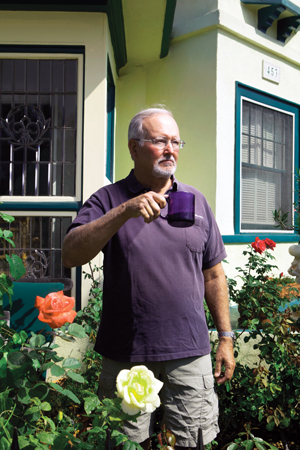
Mark Ryavec is not enthused about recent court decisions that he believes have whittled "away at the police's powers to do anything when there is a problematic situation." Photo by Kyle Monk.
Though LA's three trips to the 9th Circuit stand out, similar laws have been at issue across the United States.
And they're on the rise. In a July study examining 187 U.S. cities, the National Law Center on Homelessness and Poverty, based in Washington, D.C., found a 119 percent increase since 2011 in city bans on sleeping in vehicles. The NLCHP also found a 25 percent increase in citywide laws against begging, a 60 percent increase in citywide camping bans and a 35 percent increase in citywide loitering or vagrancy laws. This doesn't count laws that apply only to a specific district.
Similarly, Michael Stoops of the National Coalition for the Homeless says 53 cities had enacted or considered restrictions on feeding the homeless between January of 2013 and this past June. Over the last decade, Albuquerque, Dallas, Las Vegas, Orlando and Philadelphia have all been sued over feeding restrictions. (Los Angeles proposed such a law this year, but ultimately took no action.)
Jeremy Rosen, director of advocacy for the law center, believes more laws are being passed because more poverty is becoming visible.
"Why you're seeing a whole lot more of them is because it's actually occurring in a whole lot more places," says Rosen of D.C., who is also a member of the ABA's Commission on Homelessness and Poverty. "So the cities are seeing more of this than they ever saw before. They don't like it and so they're passing these laws rather than coming up with a productive way to deal with it."
When sued, cities generally defend these laws by citing concerns that food, trash and human waste litter the streets; that a homeless presence will scare customers away from commercial areas; and that helping homeless people in place prevents them from seeking out social services that could be more beneficial. Before the 9th Circuit, Los Angeles argued that the Desertrain plaintiffs were unsafe in vehicles crowded with belongings, pets and garbage.
But Rosen is not so sure. He says taking a "criminal justice approach" suggests that the city's concerns about public health are pretextual.
"Cities that use the criminal justice system are saying 'If you stick around here, you're going to go to jail,' " he says. "And that's not a productive approach for people living outdoors."
It's not productive because criminalization tends to perpetuate homelessness rather than solve it, the NLCHP report says. People without homes have limited options for where they can perform basic life activities like eating and sleeping. Businesses don't always let them in—a Venice homeless man wrote an essay for the Free Venice Beachhead blog this year about being asked to leave a Starbucks. And according to the Department of Housing and Urban Development, there are more homeless people than available shelter beds in the U.S. As a result, homeless people may not be able to avoid breaking laws that make it a crime to sleep, eat or urinate outdoors.
Desertrain has roots in a push from Venetians like Ryavec for greater police intervention. Venice has long been known as a beach community for free spirits—and it's always had a homeless population.
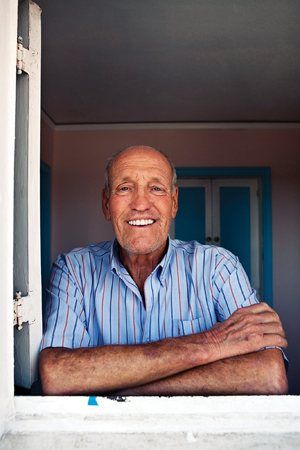
Bill Rosendahl foresees continued tension in Venice unless permanent housing options are developed. Photo by Kyle Monk.
"Venice is a magnet," says former LA city councilman Bill Rosendahl, who represented the area before he retired in 2013. "Those who have issues—psychiatric issues, homeless issues—they're just like any other person, attracted to the beach."
Venice became even more of a magnet after the LAPD got the neighborhood's 1990s gang problem under control. This brought in wealthier residents, as did the "Silicon Beach" group of tech companies clustered in LA's beach communities. (Among others, Google's LA offices are in Venice, not far from Skid Rose.)
Some perceive these newer residents as less tolerant of the homeless than longtime Venetians. Rosendahl strongly disputes this but says that "Venice has been more accommodating in the past."
At the same time, the Los Angeles Times reported in February that younger and more aggressive people have moved into the homeless population, changing its character. Ten-year resident Jack Hoffman, a neighborhood activist like Ryavec, also believes methamphetamine has changed the homeless population. Some of these new people have not proved to be good neighbors. For example, an RV dumped its septic tank along Rose Avenue in 2010, requiring the city to send a hazardous materials cleanup crew.
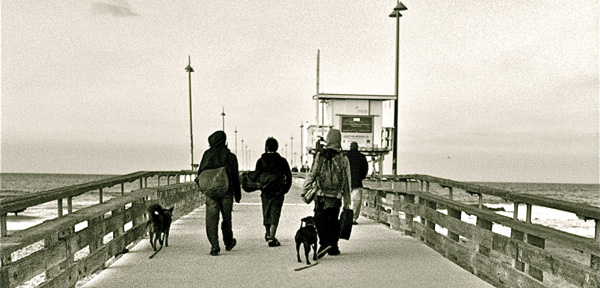
Photo by Jennifer Kelton.
The resulting community complaints brought more city pressure to bear on the area's homeless. The city stepped up police presence and enforcement with an LAPD Venice Homelessness Task Force, instituted a beach curfew between midnight and 5 a.m., approved a ban on oversize vehicles in neighborhoods that asked for them, and originally supported the Venice Stakeholders Association's fight with the California Coastal Commission for overnight parking restrictions. (The city dropped its support not long before former city attorney Carmen Trutanich left office in July 2013 after an unsuccessful re-election bid.) And LA started enforcing its 1983 ordinance forbidding living in vehicles, resulting in the citations challenged in Desertrain.
Venice residents are sharply divided on homeless issues, with some feeling threatened by the situation and others arguing that driving the homeless out changes something unique and important about Venice culture. Online debate can quickly get heated, with personal attacks on people like Ryavec and Sobel and the homeless themselves.
It spills over into the real world. In 2012, the city put a shipping container on the beach to store homeless people's property while they slept at winter shelters. The container became a subject of fierce community debate. Eventually, someone sneaked extra padlocks onto it in the middle of the night. This required the city to cut them off, creating delays for homeless people trying to collect their things.
In January, Councilmember Mike Bonin told a Venice Neighborhood Council meeting that the container was required by the Lavan decision. He called for "a more civil discourse," noting that his office had gotten numerous complaints about the container based on misinformation.
Though nothing is proven, some of the area's homeless believe the debate also leads to violence. In May, someone broke all the windows in an inhabited camper shell near Penmar Park, according to the Venice Update and Free Venice Beachhead blogs. The next night, the blogs said, someone firebombed the camper shell as its owner, Ernest Roman, lay in bed. Roman escaped, but the fire destroyed his home and almost everything he owned. In July, the Los Angeles Fire Department confirmed that a vehicle fire at that time and location was being investigated as arson.
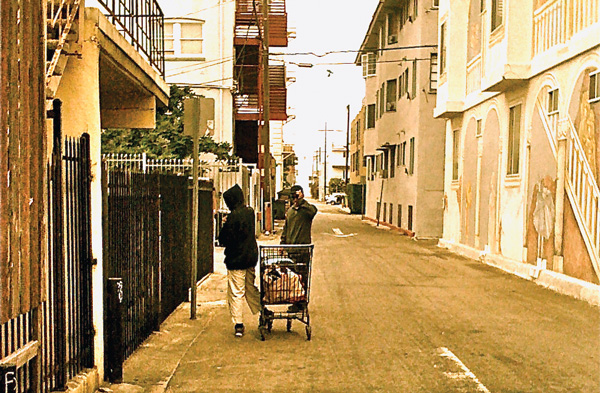
Photo by Jennifer Kelton.
UNPAID TICKETS LEAD TO CRIMINAL RECORDS
At a weekly dinner for the poor given by the First Baptist Church of Venice, vehicle-dweller Charles Moore said there are homeless people with 10, 15 or even 20 parking tickets. He said he watched a police officer pass up a chance to arrest such a person—but then issue yet another ticket, which Moore thought was an odd way to handle alleged lawbreaking.
Moore said he'd gotten four tickets himself since arriving in Venice about a month before. One was a parking ticket—which he said he'd paid because it was legitimate—and three other tickets for $197 each, which he planned to contest. One was for blocking the sidewalk; Moore said he was helping another man fix a bicycle at the time. Another was for jaywalking.
Other vehicle-dwellers at the dinner said they were given warnings during the crackdown on living in vehicles, but no tickets for living in a car. One said he was told he had to move if neighbors complained, but it wasn't illegal to sleep in the car. (This was contradicted to some extent by testimony from the Desertrain plaintiffs, one of whom started sleeping on the sidewalk after police warned him not to sleep in his car.)
Another man parked on the Pacific Coast Highway in Malibu for three months before returning to Venice. He said everyone in vehicles is "breathing a lot easier" after the Desertrain decision.
Moore claimed he was living in his car by choice and could pay the tickets. But for homeless people with very low incomes, the NLCHP report says, criminalization creates more barriers to ending homelessness. Arrests and citations generate fines they can't pay, creating bench warrants later. A criminal record can mean being turned down for jobs and for public housing subsidies, which are crucial for housing very-low-income people. Going to jail can mean losing public benefits, a job or an opportunity. And losing belongings to arrest or confiscation can mean losing basic tools like identification, cellphones and medication.
Laws like these often violate the civil rights of the homeless, or sometimes (as in cases involving church groups giving out food) their advocates. Just as the ban on living in a vehicle was found unconstitutionally vague in Desertrain, vagrancy and loitering laws have also been struck down as vague, especially when defendants can point to uneven or arbitrary enforcement. Laws prohibiting public performance of basic life activities like sleeping can be struck down under the Eighth Amendment, if homeless people have nowhere else to perform those activities. That was the ruling in LA's Jones case.
Laws permitting seizures of homeless people's property can be struck down under the 14th Amendment's due process clause and the Fourth Amendment's ban on unreasonable seizures. These formed the basis of the 9th Circuit's Lavan decision. The First Amendment right to freedom of speech prohibits blanket bans on panhandling. That was the holding of both the Richmond, Virginia-based 4th and the Cincinnati-based 6th circuits last year in Clatterbuck v. City of Charlottesville and Speet v. Schuette.
And organizations that feed the homeless have invoked their own First Amendment rights to freedom of religion or political speech. Over the past decade, federal district courts have often struck these laws down on religious freedom grounds, although the Atlanta-based 11th Circuit upheld Orlando's restrictions in 2011 as a reasonable time, place or manner restriction on political speech.
These humanitarian and civil rights concerns are why the ABA House of Delegates passed Resolution 117 at the 2013 annual meeting, urging governments to "promote the human right to adequate housing for all through increased funding, development and implementation of affordable housing strategies and to prevent infringement of that right." It was sponsored by nine ABA groups, including the ABA Commission on Homelessness and Poverty. The commission itself advocates for laws and policies to lift people out of homelessness, and it provides resources for advocates for the poorest Americans.
"The criminalization of homelessness is perhaps the least effective way to end homelessness and is a tremendous distraction from the real solutions to homelessness, which are housing and income for people in poverty," says Antonia Fasanelli, immediate-past chair of the commission and executive director of the Homeless Persons Representation Project in Baltimore.

Photo by Jennifer Kelton.
Perhaps most important for municipalities with limited budgets, letting homeless people cycle through jails and hospitals is actually more expensive to taxpayers than providing housing, research shows.
That's because homelessness tends to lead to increased reliance on emergency medical services, as well as more dealings with the criminal justice system (as both victims and perpetrators).
A few localities have tried "housing first" models and documented considerable savings. One of the first such programs was the Albuquerque Heading Home initiative, which was launched in January 2011. The goal was to house some of the city's toughest cases: chronically homeless people who had documented behavioral health and substance abuse problems. Those people are usually the most vulnerable within the homeless population—and use the most police and medical services. Combining a mixture of public and private funding, the program moved those individuals into housing and provided social workers to address their underlying problems.
After a year in the program, a University of New Mexico study found, clients were costing the public 31 percent less than they had the previous year—an average of $12,831.68 less per person. Those savings largely came from less use of emergency rooms, hospitals, jails and jail-based treatment programs. Albuquerque Mayor Richard Berry said in June that the city saved $3.2 million over the three years of the program.
So why don't more cities try it? Rosen suggests that the greater immediate cost of supportive housing might blind people to the long-term costs of overusing the criminal justice system.
"It requires a willingness and ability to make that upfront investment," he says. "There's a desire to find an immediate solution that doesn't cost money, and so people turn to 'Well, just arrest everyone.' Of course, that does actually cost money."
There have already been some efforts toward housing-first programs in Los Angeles County, although none directly sponsored by the city. One was Los Angeles County's Project 50, which from 2007 to 2012 sought to permanently house 50 chronically homeless, vulnerable people on downtown LA's notorious Skid Row. In the end, a county report says, the project housed 67 people and saved more money than its cost to taxpayers.
Also underway is the Home for Good initiative, a collaboration between the United Way of Greater Los Angeles and the Los Angeles Area Chamber of Commerce, which seeks to end chronic and veteran homelessness by 2016. Program Associate Emily Bradley says it works closely with several area governments, including that of Los Angeles, and had housed 14,249 people through April.
The city itself has taken a softer approach. In 2010, when homelessness became a serious issue in Venice, then-councilman Rosendahl started Vehicles to Homes, a program that he later said moved about 100 people into stationary homes.
Rosendahl also wanted to establish a parking lot where vehicle-dwellers could park for the night legally and have access to social services, modeled after programs in Santa Barbara, California, and Eugene, Oregon. But Sobel says Rosendahl was stymied by community opposition to all three of the potential sites. (Rosendahl says a site near LAX is still under consideration.)
"This is the problem with homelessness in LA generally," says Sobel. "There is not the political will to address the solutions; there is only the political will to put people in jail. And that doesn't address anything."
A similar problem arose when advocates for the homeless made plans to establish permanent supportive housing for homeless veterans at the VA campus in West Los Angeles. The land is expressly designated for veterans' care, but it's also near the expensive neighborhoods of Brentwood and Westwood, and some of those residents didn't want the project nearby.
Advocates say those complaints caused government agencies to slow the project. Though the permanent supportive housing was announced in 2007, renovations on the three abandoned buildings chosen didn't start until 2010. And the original federal funding allocated was enough for renovating only one of the buildings, Rosendahl says, with nothing left over for staffing. Rosendahl believes the city can't solve its homelessness problems without greater funding and support from other levels of government. "Venice will continue to have tensions until we get permanent housing," he says. "And we're talking about tens of millions of dollars, and actually talking about hundreds of millions of dollars."
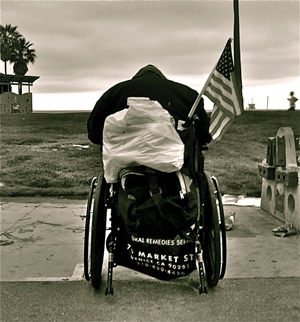
A homeless veteran displays his patriotism along the shores of Venice Beach. Photo by Jennifer Kelton.
At least some funding might be coming.
In July, Mayor Eric Garcetti pledged to join the Obama administration's Mayors Challenge to End Veteran Homelessness, which advocates a housing-first approach. Garcetti was reportedly in talks to secure related federal funding.
There are also signs that the city is changing its day-to-day approach to homelessness. City officials said in July that the LAPD would reduce arrests on downtown's Skid Row for petty offenses. And the Los Angeles Homeless Services Authority, an entity that coordinates homeless services for most of the county, has begun offering social services on Skid Row in combination with major street-cleaning efforts.
As for vehicle-dwellers, City Attorney Mike Feuer said in June that he wouldn't appeal Desertrain. Instead, he said he would work with other city officials to write a new law that balances homeless civil rights with neighborhood quality-of-life issues.
But Sobel isn't optimistic about those changes. As of August, she says, the 1,250 units of supportive housing ordered by the settlement in Jones were nearly built. In fact, she says the city even allocated general-fund money for that purpose in 2013. That means the city will soon no longer be enjoined from enforcing its law against sitting, sleeping or lying on sidewalks at night.
The city "went out of its way to speed it up ... so that, as one of the council people said when they came out of closed session, they can return to enforcement," Sobel says. It's "not over, and they know they're going to get sued again."
This article originally appeared in the November 2014 issue of the ABA Journal with this headline: "Unwanted Guests: Trying to manage a growing homeless population, Los Angeles and other cities get mired in civil rights disputes."
Clarification
“Unwanted Guests,” November, should have described Mark Ryavec’s duplex as being built about 1905. The Los Angeles County assessor’s office lists that date and 1947. Ryavec says the house was built in 1907 and a two-bedroom structure in back was built in 1949.



